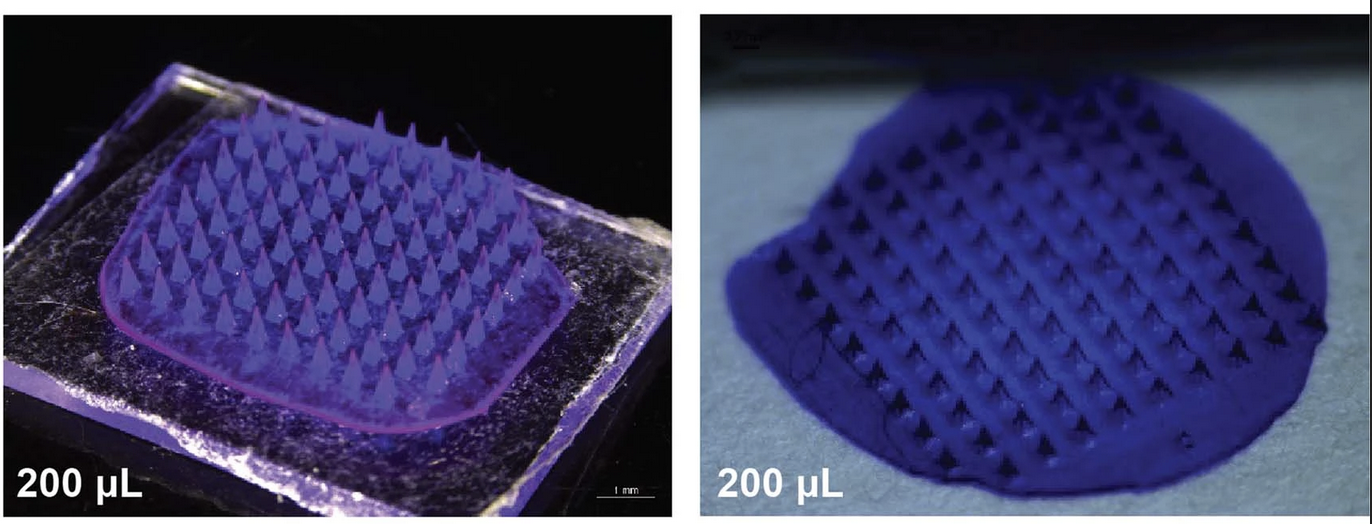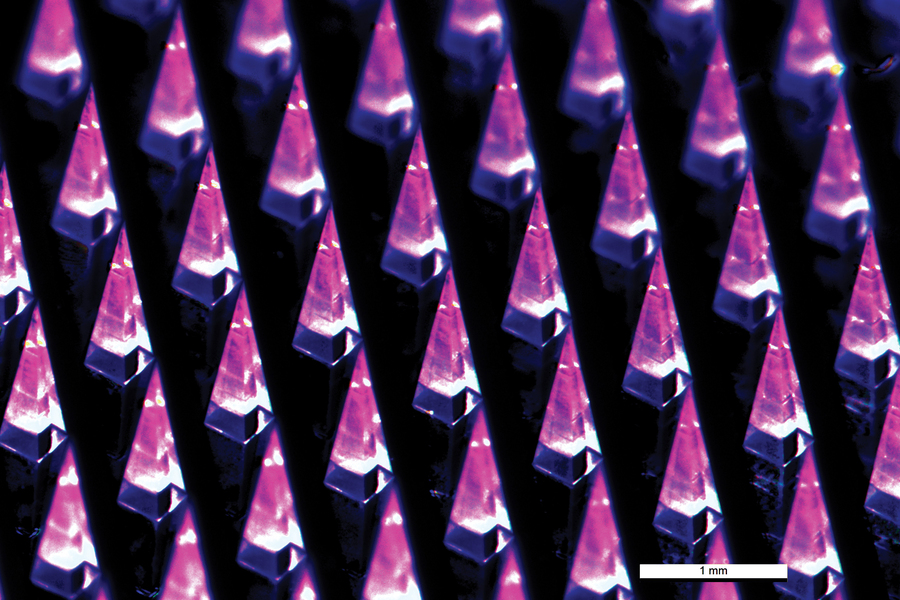A 3D printer developed by researchers at the Massachusetts Institute of Technology (MIT) could make waves in the field of vaccine delivery. The mobile vaccine printer, capable of producing hundreds of microneedle vaccine patches per day, could be deployed anywhere vaccines are needed and revolutionize the way they are administered.
According to a study published in the journal Nature Biotechnology, researchers showed how they used the printer to produce Covid-19 messenger-RNA (m-RNA) microneedle patch vaccines that could stimulate long-term immune responses similar to those of intramuscular administration in mice. Furthermore, the team demonstrated that the microneedle patches can be stored at room temperature for six months without losing their efficacy.
 MIT’s microneedle patches. Image courtesy of MIT/Nature Biotechnology journal.
MIT’s microneedle patches. Image courtesy of MIT/Nature Biotechnology journal.While they are generally safe and effective, traditional vaccines administered through a needle and syringe are at a disadvantage compared to modern microneedle vaccines. Aside from the pain and discomfort associated with intramuscular vaccines, there’s also a risk of injury to the nerve and infection at the injection site, as well as a need for administration by trained healthcare professionals. Instead, microneedle vaccines could help overcome needle phobias (estimated between 10% to 20% of the population) and have the potential to be self-administered, increasing their access in underserved areas.
Instead of producing injectable vaccines, a team of scientists led by former MIT postdoctoral researcher Aurélien vander Straeten, mechanical engineer Morteza Sarmadi, and postdoctoral associate John Daristotle turned to 3D printing to make a friendlier version.
Titled “A microneedle vaccine printer for thermostable COVID-19 mRNA vaccines,” the study was also authored by two of MIT’s leading scientists, Ana Jaklenec from the Koch Institute for Integrative Cancer Research and Robert Langer, heralded as one of the most prolific inventors in the history of medicine and Koch Institute professor.
 MIT’s printer produces patches with hundreds of microneedles containing vaccine. Image courtesy of MIT researchers.
MIT’s printer produces patches with hundreds of microneedles containing vaccine. Image courtesy of MIT researchers.Novel microneedle patches are typically handmade individually with labor-intensive, manual, and imprecise steps, such as centrifugation, state the researchers. Instead, their microneedle vaccine printer dispenses vaccine ink using a robotic arm that fills microneedle molds using a vacuum to remove air and accelerate drying.
Using an automated workflow with minimal human intervention, the prototype printer is capable of manufacturing 100 patches in 48 hours. However, the team is already working on changing the size and complexity of the dispensing stage and drying area to increase the scale of production.
 MIT’s printer dispensing vaccine ink in molds. Image courtesy of MIT/Nature Biotechnology journal.
MIT’s printer dispensing vaccine ink in molds. Image courtesy of MIT/Nature Biotechnology journal.“We could someday have on-demand vaccine production,” Jaklenec said to MIT News. “If, for example, there was an Ebola outbreak in a particular region, one could ship a few of these printers there and vaccinate the people in that location.”
For the vaccine ink, the study used lipid nanoparticles loaded with mRNA and a dissolvable polymer blend that was optimized for high bioactivity by screening formulations in vitro. In each run, the microneedle vaccine printer dispenses vaccine ink to fill the microneedle molds without disrupting the ink.
Loading of increasingly viscous inks required less than 20 minutes. By applying vacuum directly to the mold, the team prevented bubble formation and eliminates the need for centrifugation, providing a repeatable process that can be scaled up or down.
To test the microneedle vaccine’s ability to stimulate an immune response, two doses were administered to mice four weeks apart. According to the results, mice vaccinated with the microneedle patch had a similar response to mice vaccinated with a traditional, injected RNA vaccine. However, when both microneedle and traditional vaccines were stored at room temperature, it is clear that the intramuscular suspension’s potency decreases during a six-month period, while microneedle patch vaccines produce consistently high luminescence over the entire storage period.
 MIT uses robotic arm to inject ink into microneedle molds, and a vacuum chamber below the mold sucks the ink down to the bottom. Image courtesy of MIT.
MIT uses robotic arm to inject ink into microneedle molds, and a vacuum chamber below the mold sucks the ink down to the bottom. Image courtesy of MIT.Overall, the study concludes that room-temperature-stable vaccines would greatly facilitate deployment in developing nations, where the supply chain necessary for cold transport may be inefficient. They would also allow for vaccines to be cost-efficiently stockpiled in preparation for a potential outbreak. With the potential to greatly improve access to vaccines, the MIT team’s 3D printer is a promising development in the fight against infectious diseases
Although the team acknowledges that so far, thermostable mRNA-LNP vaccines have not been developed, there have been other recent efforts to 3D print microneedle patch vaccines. One of the most recent examples is a 3D printer developed by researchers at the University of California, Los Angeles (UCLA), capable of producing hundreds of microneedle vaccine patches per day. At less than a millimeter in length, these microneedles can be printed onto a patch that can be applied to the skin like a bandage. The study demonstrated the effectiveness of the patches in delivering a flu vaccine to mice, showing that the microneedles were able to successfully penetrate the skin and stimulate antibodies.
Similarly, researchers from the University of Texas at Austin published a paper in the journal Advanced Materials describing the development of a new method for 3D printing dissolvable microneedle vaccines. The technique involves printing the microneedles using a sugar-based material that can dissolve upon contact with the skin, releasing the vaccine in a controlled and targeted manner.
Subscribe to Our Email Newsletter
Stay up-to-date on all the latest news from the 3D printing industry and receive information and offers from third party vendors.
Print Services
Upload your 3D Models and get them printed quickly and efficiently.
You May Also Like
Making Space: Stratasys Global Director of Aerospace & Defense Conrad Smith Discusses the Space Supply Chain Council
Of all the many verticals that have been significant additive manufacturing (AM) adopters, few have been more deeply influenced by the incorporation of AM into their workflows than the space...
EOS in India: AM’s Rising Star
EOS is doubling down on India. With a growing base of aerospace startups, new government policies, and a massive engineering workforce, India is quickly becoming one of the most important...
PostProcess CEO on Why the “Dirty Little Secret” of 3D Printing Can’t Be Ignored Anymore
If you’ve ever peeked behind the scenes of a 3D printing lab, you might have caught a glimpse of the post-processing room; maybe it’s messy, maybe hidden behind a mysterious...
Stratasys & Automation Intelligence Open North American Tooling Center in Flint
Stratasys has opened the North American Stratasys Tooling Center (NASTC) in Flint, Michigan, together with automation integrator and software firm Automation Intelligence. Stratasys wants the new center to help reduce...


































